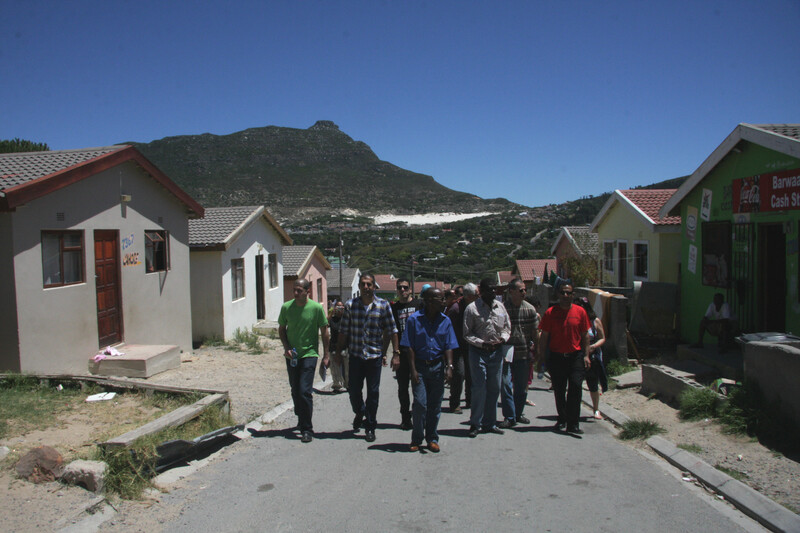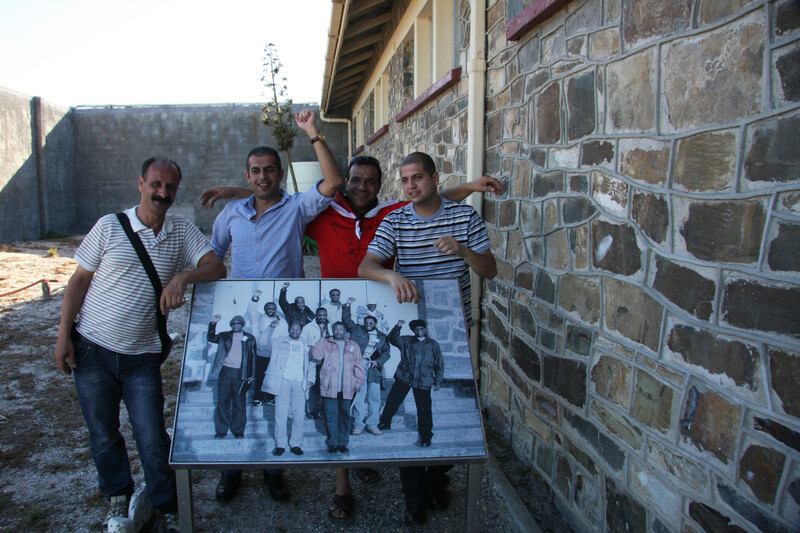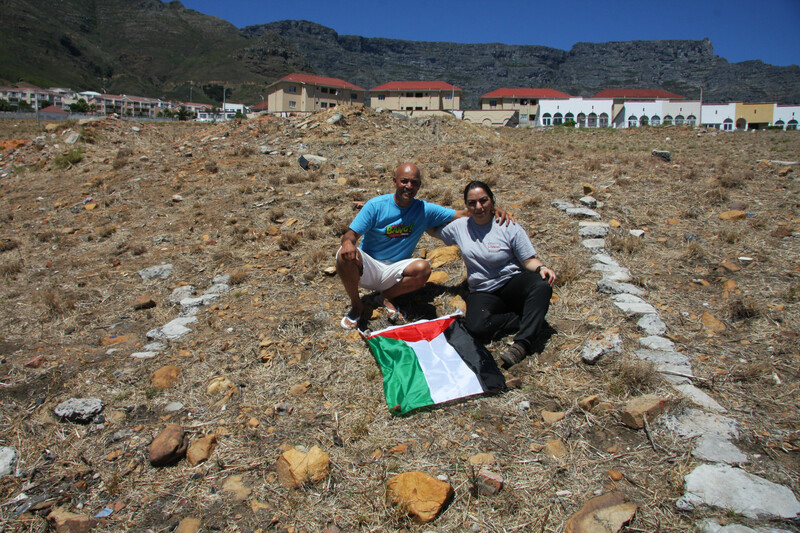The Electronic Intifada Berkeley 5 June 2012

Visiting the Imizami Yethu township in Cape Town, delegates learned about the workers’ movement in post-apartheid South Africa.
In February, a delegation of activists and scholars working on the Palestinian right of return came together in Cape Town, South Africa, to discuss the practicalities of return, 64 years and counting since the forced expulsion of more than 750,000 Palestinians in 1947-48. Participants also learned from South Africa’s experience of implementing its return of internally-displaced Blacks after White minority rule officially ended in the mid-1990s.
Delegates were affiliated with Badil, the Bethlehem-based Palestinian Center for Residency and Refugee Rights, and Zochrot, the Israeli anti-Zionist organization dedicated to educating the Israeli public about the Nakba (the systematic ethnic cleansing of Palestinians in the 1940s) and the right of return. Following the workshops in Cape Town, delegates worked on discussion papers on the right of return, which have been published in Badil’s English-language quarterly magazine, al-Majdal.
Hazem Jamjoum, a delegate to Cape Town and the editor of al-Majdal, was interviewed by Nora Barrows-Friedman for The Electronic Intifada.
Nora Barrows-Friedman: Talk about your visit to Cape Town. What were the intentions and expectations of working in collaboration with Badil and Zochrot against the physical and historical backdrop of South Africa’s struggle against racism, colonialism and apartheid?
Hazem Jamjoum: For years now, South African apartheid has been one of the most important comparison cases used both to understand and explain Israel’s regime over Palestinians. A central part of the South African struggle, one that’s usually not talked about, is that mass forced displacement was central to the South African apartheid regime.
The difference between the South African experience and ours in Palestine is that displacement in South Africa was almost completely internal, in the sense that millions of Blacks classified into different racial groups under the law were forcibly removed from areas zoned for other racial groups under the Group Areas Act, or outright carted off to the Bantustans — that is, they were not expelled from the country. Most of Israel’s forced displacement of Palestinians has been external, beyond the borders of territories that came under Israel’s control.
The reason for this difference is at the core of the difference between these two versions of apartheid: the South African version was based on an institutional segregation where Blacks would be concentrated in the reserves/Bantustans, policed by their own native authorities for the purpose of reproducing an army of cheap labor for white South African business. The Israeli version incorporates some of these aspects (especially these days with the Palestinian Authority policing Palestinian reserves), but Palestinian labor, while used as a cheap labor force especially in the 1970s and 80s and still until this day although less so, was never central to Israeli apartheid.
Israeli apartheid is used as a means of continuing the forced displacement of Palestinians, with the ultimate goal of ensuring that the maximum of Palestinian land is under exclusive Jewish-Zionist control, and that the minimum of Palestinians remain on that land.
This said, because forced removals were so rampant (and central) to the South African regime of apartheid, the struggle against South African apartheid, like the Palestinian struggle, was also a struggle for return of the displaced and a struggle to get back the stolen land. It was this experience, the experience of actual return since South Africa’s liberation in 1994, and the lessons that South African activists had drawn from return that we hoped people would share with us to help us develop our vision for what our return could look like, and maybe some of the things we should stress or avoid.

Palestinian participants, all having experienced detention and imprisonment by Israel, at Robben Island, the most infamous of the South African apartheid regime’s prisons.
NBF: What were some of the most meaningful and strategically-important discussions and plans that came out of the workshops?
HJ: I think all of them were very meaningful and important. I can speak the most about the part that I was most involved in, which was the discussion on reparations. The other two main topic areas were on the various aspects of the work needed in preparation of the return of Palestinian refugees and on attempts to propose mechanisms, processes and ideas for the post-colonial and transitional stage in Palestine involving things like reconciliation, justice and trauma healing that we learned a lot about in Cape Town, as well as really interesting discussions on “de-Zionizing” things like culture and education.
The reparations discussion started off as a discussion on restitution, which is a legal term for getting back something that was wrongfully taken from you. I think the shift from a discussion of restitution to one on the broader notion of reparations was significant in itself. NGOs [non-governmental organizations] and “rights based” discussions on the right of return focus on restitution because it is really strong in international law and integral to the right of return. The reason it’s so strong is because international law is largely premised on a capitalist world order, so the right to property is held to be almost as sacred as the right to life. If someone takes your property, and the law doesn’t do anything about it, capitalism can’t function; it falls apart (of course this may apply in law but not in practice if the one stealing your property is the representative of global capital and empire in your neighborhood).
The right to restitution was made a constitutional right in South Africa, and it kind of became the central axis for post-apartheid reparations, and people who’ve been following the reparations process in South Africa have come to see this as a problem.
I can explain the problem using Palestinian examples. A Palestinian village depopulated by Zionist forces in 1948 that had, let’s say, 1,000 inhabitants would now have tens of thousands of Palestinians who want to return to it as their home. If we think only in terms of restitution, only those who owned property before they were displaced would have a strong claim for restitution; and even that claim would have to be divided up between all the heirs of the refugee landowner who initially had title to the land.
So we’d end up with a massive majority of returning refugees who would be completely landless, a minority who would end up with small bits of land divided between their siblings and cousins, and a very tiny minority, the descendants of the biggest landlords, who would have land that you could do something with. (Rich refugees would also have an upper hand with things like access to top lawyers and resources to ensure they got the most out of a restitution process.)
Another aspect of the discussion was that if the focus was just on land and property, you could end up destroying things like productive farms, factories, et cetera that would be essential for ensuring that returning refugees can live off the resources of their stolen land; you could also end up turning the lands of once beautiful villages into concrete jungles the way Israeli settlements violate the landscape wherever you look in the West Bank today.
Some of the other discussions focused on the fate of Israeli settlers and occupants on Palestinian lands and in Palestinian houses. This is a particularly thorny issue because it would contradict everything our struggle stands for if we take the position that we have to throw people out of where they live.
The South African experience was one where the government and the market acted as the mediators, the government would try to see what price the White occupant would accept to sell the property, and if it could be done, the state bought the property and gave it back to its rightful owners. This ended up, to some degree, rewarding perpetrators of apartheid, diverting important state funds for individual cases, and creating a kind of reliance on the government that has many Black activists today describing it as a “nanny state.”
Related to all of this was that the transition from racial apartheid in South Africa, although being a major victory for peoples’ struggles everywhere, hasn’t changed much of what is a clear case of economic apartheid. Blacks made up the lower classes, and today the areas that were for “Blacks only,” are for “poor only” so it feels like it hasn’t really changed much. Black people can walk round the rich areas without being asked for their IDs, and if they’ve been part of the very few who’ve joined the middle or upper class they can buy property and live in these areas (although the only Black folks I saw in these areas were domestic workers walking white folks’ dogs or babysitting their children), and we didn’t see any White folks in the townships other than tourists with very expensive cameras (eerily reminiscent of what goes on in places like Palestinian refugee camps).
Some of our most meaningful discussions with South African activists were about the struggle going on in South Africa today against the different aspects of the ongoing economic apartheid like poverty, landlessness, evictions, anti-migrant xenophobia and how the post-apartheid transition was largely managed by major corporations, the IMF and the World Bank, and how this has contributed to some of the failures of the return process.
This was why so much of our discussion focused on redistribution, refugees leading the process of how we want our communities to look and operate, how we think we can make sure people can have a decent life after we return, and not just be the poor and unemployed class of a post-facelift Israel.
NBF: Talk about the implementation of the right of return — its feasibility and what the first step is. How are organizations such as Badil and Zochrot working on a practical level to realize the right of return?
HJ: Essentially all the work of Badil and Zochrot is for the implementation of the right of return, so if I was to list these things I’d sound a little bit like the “about” page on their websites. I can’t speak so much for Zochrot, which does amazing work on breaking the Zionist taboo on opening up discussions on the Nakba and the centrality of refugee return. Badil works on several levels including advocacy at the UN and other international forums, education activity among Palestinian activists and especially younger people, doing the research and documentation work that supports much of the right of return movement. Both organizations are heavily involved in mobilization and activism as part of the return movement, and Badil is particularly invested in the campaigns for boycotts, divestment and sanctions (BDS) as one of the ways to support the different aspects of the Palestinian struggle.
In terms of feasibility, the issue of refugee return has never been about a lack of space or resources. It’s political. Israel was founded on the idea of being a Jewish-democratic state, which means a democratic system that requires a Jewish demographic majority that could only be achieved by ensuring that the actual native majority is excluded from the political system, much like the way South Africa was a democratic system for Whites that required that the native majority be excluded. Israel achieved this in two ways, the first by expelling and not allowing the native population to be physically present to participate in this democracy, and second by ensuring that Palestinians in the part of Palestine occupied in 1967 have been excluded from the political system by keeping them under occupation.
Israel has been able to keep this going through a combination of military force, international support and integration into the global economy, as well as continually growing domestic support and participation in the continuation of the Israeli apartheid regime that maintains Jewish privilege; and a Palestinian “partner for peace” that allows Israel to deflect any criticism through a combination of blaming Palestinians for not doing enough and the ability to point to the ongoing “peace process” charade that acts as a smokescreen for ongoing Israeli crimes.
So the struggle for return and the struggle for the liberation of Palestine are one and the same, a struggle to be re-included by physically returning and being part of the political system — which we think of as a struggle to get our country and land back — by undermining each of the pillars of Israeli power that enable it to maintain itself as an apartheid regime. The first steps in this struggle have already been taken, the point now is to ensure that it grows to the point where it is able to achieve its goals, and to ensure that it is not co-opted along the way in the way that it has been in the past.

Anti-apartheid activist Aslam Levy and Palestinian artist Rana Bishara on the site of homes in District 6 that were demolished during forced removals. Levy’s home was one of them.
NBF: After the work that was done to address all of this in Cape Town, what’s the next step? What are you looking forward to, or are most concerned about?
HJ: Regarding the Cape Town discussion documents, I just hope people will read and discuss them. There have always been two main tendencies in the Palestinian struggle, and these aren’t two groups of people, they exist to varying degrees in every one of us. One tendency dreams of kicking out the colonizer in the way that anti-colonial movements in the past fifty years have done in Algeria, Vietnam and elsewhere. This is the strand that grows stronger every time Israel commits a massacre or an atrocity, every time an Israeli politician talks about how Palestinians are cockroaches, every time a house is demolished, an olive tree uprooted, a prisoner tortured.
The other tendency is the one that sees a future in which Palestinians’ rights are restored, and where all those who consider Palestine home, regardless of their religion, can live and struggle together as equals. The discussion documents are an attempt to start thinking about the practicalities and challenges facing this second tendency.
In many ways, the discussions were very lofty, and some will no doubt call them idealistic — perhaps even romantic. But if we’re serious about return, we need the space to take a brief step away from the demonstrations and agitation of everyday to also think about what it will look like, what could go wrong and what could go right.
Studying other examples of struggles for return, especially ones that achieved combinations of success and failure, is one way of doing this, and obviously it’s a privilege to be able to do this directly by visiting a place like Cape Town. In many ways, the questions raised in these documents are at least as important as our attempts to answer them. By reading them and thinking about the questions they pose, we move from a conception of return as a kind of slogan (or in the case of Zionists as a bogeyman) to thinking about return as a concrete reality.
Shifting our thinking in this way allows for discussion of the kinds of things that we can be doing that are in many ways quite different from what the return movement looks like now, and the hope is that by making this shift, we take a step closer to transforming return from a dream to a reality.
The documents referred to in this article can be found on the Badil website.
Nora Barrows-Friedman is an associate editor for The Electronic Intifada.





